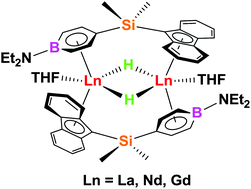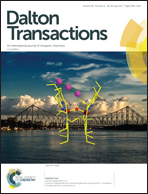Rare-earth metal hydrides supported by silicon-bridged boratabenzene fluorenyl ligands: synthesis, structure and reactivity†
Abstract
The reactions of rare-earth metal benzyl complexes supported by silicon-bridged boratabenzene fluorenyl ligands with PhSiH3 in toluene gave the corresponding dinuclear hydrides [{μ-[Me2Si(C13H8)(C5H4BNEt2)]}Ln(μ-H)(THF)]2 (3-Ln; Ln = La, Nd, Gd), wherein the rare-earth metal ions are linked by both silicon-bridged boratabenzene fluorenyl ligands and hydrido ligands. The reactivity of these hydrides toward unsaturated substrates was studied. Among these, alkynides [{μ-[Me2Si(C13H8)(C5H4BNEt2)]}Ln(μ-CCPh)]2 (4-Ln; Ln = La, Nd) were obtained via the σ-bond metathesis reaction, when 3-Ln (Ln = La, Nd) was treated with phenylacetylene. While reacting with 3-hexyne, the mono-addition product [{μ-[Me2Si(C13H8)(C5H4BNEt2)]}Ln]2(μ-H)[μ-C(Et)![[double bond, length as m-dash]](https://www.rsc.org/images/entities/char_e001.gif) C(H)Et] (5-Ln; Ln = La, Nd) was formed. Further investigations on the reactivity of 3-La displayed that benzonitrile and tert-butyl isonitrile readily inserted into the La–H bonds, affording an azomethine complex [{μ-[Me2Si(C13H8)(C5H4BNEt2)]}La{μ-N
C(H)Et] (5-Ln; Ln = La, Nd) was formed. Further investigations on the reactivity of 3-La displayed that benzonitrile and tert-butyl isonitrile readily inserted into the La–H bonds, affording an azomethine complex [{μ-[Me2Si(C13H8)(C5H4BNEt2)]}La{μ-N![[double bond, length as m-dash]](https://www.rsc.org/images/entities/char_e001.gif) C(H)Ph}]2 (6-La) and an N-tert-butylformimidoyl complex [{μ-[Me2Si(C13H8)(C5H4BNEt2)]}La{μ,η2-C(H)
C(H)Ph}]2 (6-La) and an N-tert-butylformimidoyl complex [{μ-[Me2Si(C13H8)(C5H4BNEt2)]}La{μ,η2-C(H)![[double bond, length as m-dash]](https://www.rsc.org/images/entities/char_e001.gif) NtBu}]2 (7-La), respectively. The reaction with N,N′-diisopropylcarbodiimide at room temperature or at 75 °C gave a dimeric complex [{μ-[Me2Si(C13H8)(C5H4BNEt2)]}La]2(μ-H)[μ-N(iPr)CHN(iPr)] (8-La) or a monomeric complex [Me2Si(C13H8)(C5H4BNEt2)]La[N(iPr)CHN(iPr)] (9-La), respectively.
NtBu}]2 (7-La), respectively. The reaction with N,N′-diisopropylcarbodiimide at room temperature or at 75 °C gave a dimeric complex [{μ-[Me2Si(C13H8)(C5H4BNEt2)]}La]2(μ-H)[μ-N(iPr)CHN(iPr)] (8-La) or a monomeric complex [Me2Si(C13H8)(C5H4BNEt2)]La[N(iPr)CHN(iPr)] (9-La), respectively.



 Please wait while we load your content...
Please wait while we load your content...